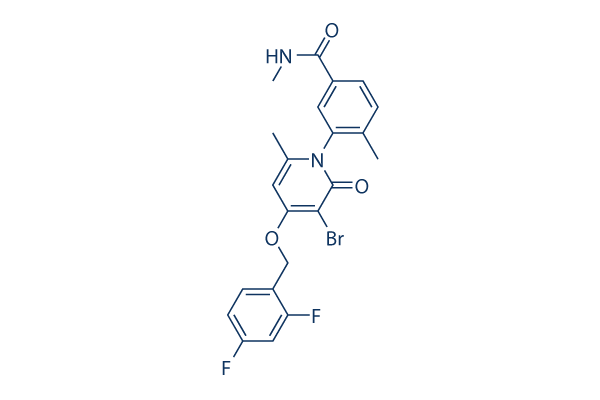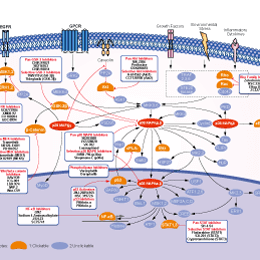
- Bioactive Compounds
- By Signaling Pathways
- PI3K/Akt/mTOR
- Epigenetics
- Methylation
- Immunology & Inflammation
- Protein Tyrosine Kinase
- Angiogenesis
- Apoptosis
- Autophagy
- ER stress & UPR
- JAK/STAT
- MAPK
- Cytoskeletal Signaling
- Cell Cycle
- TGF-beta/Smad
- DNA Damage/DNA Repair
- Compound Libraries
- Popular Compound Libraries
- Customize Library
- Clinical and FDA-approved Related
- Bioactive Compound Libraries
- Inhibitor Related
- Natural Product Related
- Metabolism Related
- Cell Death Related
- By Signaling Pathway
- By Disease
- Anti-infection and Antiviral Related
- Neuronal and Immunology Related
- Fragment and Covalent Related
- FDA-approved Drug Library
- FDA-approved & Passed Phase I Drug Library
- Preclinical/Clinical Compound Library
- Bioactive Compound Library-I
- Bioactive Compound Library-Ⅱ
- Kinase Inhibitor Library
- Express-Pick Library
- Natural Product Library
- Human Endogenous Metabolite Compound Library
- Alkaloid Compound LibraryNew
- Angiogenesis Related compound Library
- Anti-Aging Compound Library
- Anti-alzheimer Disease Compound Library
- Antibiotics compound Library
- Anti-cancer Compound Library
- Anti-cancer Compound Library-Ⅱ
- Anti-cancer Metabolism Compound Library
- Anti-Cardiovascular Disease Compound Library
- Anti-diabetic Compound Library
- Anti-infection Compound Library
- Antioxidant Compound Library
- Anti-parasitic Compound Library
- Antiviral Compound Library
- Apoptosis Compound Library
- Autophagy Compound Library
- Calcium Channel Blocker LibraryNew
- Cambridge Cancer Compound Library
- Carbohydrate Metabolism Compound LibraryNew
- Cell Cycle compound library
- CNS-Penetrant Compound Library
- Covalent Inhibitor Library
- Cytokine Inhibitor LibraryNew
- Cytoskeletal Signaling Pathway Compound Library
- DNA Damage/DNA Repair compound Library
- Drug-like Compound Library
- Endoplasmic Reticulum Stress Compound Library
- Epigenetics Compound Library
- Exosome Secretion Related Compound LibraryNew
- FDA-approved Anticancer Drug LibraryNew
- Ferroptosis Compound Library
- Flavonoid Compound Library
- Fragment Library
- Glutamine Metabolism Compound Library
- Glycolysis Compound Library
- GPCR Compound Library
- Gut Microbial Metabolite Library
- HIF-1 Signaling Pathway Compound Library
- Highly Selective Inhibitor Library
- Histone modification compound library
- HTS Library for Drug Discovery
- Human Hormone Related Compound LibraryNew
- Human Transcription Factor Compound LibraryNew
- Immunology/Inflammation Compound Library
- Inhibitor Library
- Ion Channel Ligand Library
- JAK/STAT compound library
- Lipid Metabolism Compound LibraryNew
- Macrocyclic Compound Library
- MAPK Inhibitor Library
- Medicine Food Homology Compound Library
- Metabolism Compound Library
- Methylation Compound Library
- Mouse Metabolite Compound LibraryNew
- Natural Organic Compound Library
- Neuronal Signaling Compound Library
- NF-κB Signaling Compound Library
- Nucleoside Analogue Library
- Obesity Compound Library
- Oxidative Stress Compound LibraryNew
- Plant Extract Library
- Phenotypic Screening Library
- PI3K/Akt Inhibitor Library
- Protease Inhibitor Library
- Protein-protein Interaction Inhibitor Library
- Pyroptosis Compound Library
- Small Molecule Immuno-Oncology Compound Library
- Mitochondria-Targeted Compound LibraryNew
- Stem Cell Differentiation Compound LibraryNew
- Stem Cell Signaling Compound Library
- Natural Phenol Compound LibraryNew
- Natural Terpenoid Compound LibraryNew
- TGF-beta/Smad compound library
- Traditional Chinese Medicine Library
- Tyrosine Kinase Inhibitor Library
- Ubiquitination Compound Library
-
Cherry Picking
You can personalize your library with chemicals from within Selleck's inventory. Build the right library for your research endeavors by choosing from compounds in all of our available libraries.
Please contact us at [email protected] to customize your library.
You could select:
- Antibodies
- Bioreagents
- qPCR
- 2x SYBR Green qPCR Master Mix
- 2x SYBR Green qPCR Master Mix(Low ROX)
- 2x SYBR Green qPCR Master Mix(High ROX)
- Protein Assay
- Protein A/G Magnetic Beads for IP
- Anti-Flag magnetic beads
- Anti-Flag Affinity Gel
- Anti-Myc magnetic beads
- Anti-HA magnetic beads
- Magnetic Separator
- Poly DYKDDDDK Tag Peptide lyophilized powder
- Protease Inhibitor Cocktail
- Protease Inhibitor Cocktail (EDTA-Free, 100X in DMSO)
- Phosphatase Inhibitor Cocktail (2 Tubes, 100X)
- Cell Biology
- Cell Counting Kit-8 (CCK-8)
- Animal Experiment
- Mouse Direct PCR Kit (For Genotyping)
- New Products
- Contact Us
PH-797804
PH-797804 is a novel pyridinone inhibitor of p38α with IC50 of 26 nM in a cell-free assay; 4-fold more selective versus p38β and does not inhibit JNK2. Phase 2.

PH-797804 Chemical Structure
CAS No. 586379-66-0
Purity & Quality Control
Batch:
Purity:
99.07%
99.07
PH-797804 Related Products
| Related Targets | p38α p38β | Click to Expand |
|---|---|---|
| Related Products | Adezmapimod (SB203580) SB202190 Doramapimod (BIRB 796) Ralimetinib (LY2228820) dimesylate VX-702 Losmapimod SB239063 Neflamapimod (VX-745) BMS-582949 Skepinone-L Asiatic Acid TAK-715 Pamapimod Pexmetinib SD 0006 R1487 PD 169316 | Click to Expand |
| Related Compound Libraries | Kinase Inhibitor Library MAPK Inhibitor Library Cell Cycle compound library TGF-beta/Smad compound library Anti-alzheimer Disease Compound Library | Click to Expand |
Signaling Pathway
Cell Data
| Cell Lines | Assay Type | Concentration | Incubation Time | Formulation | Activity Description | PMID |
|---|---|---|---|---|---|---|
| human U937 cells | Function assay | Inhibition of p38alpha kinase-dependent HSP-27 phosphorylation in human U937 cells, IC50=0.00105 μM | 21620699 | |||
| human monocytes | Function assay | Antiinflammatory activity in human monocytes assessed as inhibition of LPS-induced TNFalpha production, IC50=0.0034 μM | 21620699 | |||
| human PBMC | Function assay | Antiinflammatory activity in human PBMC assessed as inhibition of LPS-induced TNFalpha release pretreated for 1 hr before LPS treatment measured after 18 hrs, IC50=0.015 μM | 21641211 | |||
| Click to View More Cell Line Experimental Data | ||||||
Biological Activity
| Description | PH-797804 is a novel pyridinone inhibitor of p38α with IC50 of 26 nM in a cell-free assay; 4-fold more selective versus p38β and does not inhibit JNK2. Phase 2. | ||||
|---|---|---|---|---|---|
| Targets |
|
| In vitro | ||||
| In vitro | PH-797804 blocks LPS-induced TNF-α production and p38 kinase activity in the human monocytic U937 cell line, with comparable IC50 of 5.9 nM and 1.1 nM. PH-797804 has no inhibitory effect on either the JNK pathway (c-Jun phosphorylation) or ERK pathway (ERK phosphorylation) in U937 cells at concentrations up to 1 μM. PH-797804 inhibits RANKL- and M-CSF-induced osteoclast formation in a concentration-dependent manner, with IC50 of 3 nM in primary rat bone marrow cells. [1] IC50 values for PH-797804 against the following targets have been determined to be greater than 200 μM (unless specified): CDK2, ERK2, IKK1, IKK2, IKKi, MAPKAP2, MAPKAP3, MKK7 (>100 μM), MNK, MSK (>164 μM), PRAK, RSK2, and TBK1, which means the activity of PH-797804 is specific. [2] | |||
|---|---|---|---|---|
| Kinase Assay | P38 kinase assay | |||
| A resin capture assay method is used to determine the phosphorylation of epidermal growth factor receptor peptide (EGFRP) or GST-c-Jun by p38 kinases. Reactions mixtures contain 25 mM HEPES, pH 7.5, 10 mM magnesium acetate, ATP (at the indicated concentration), 0.05 to 0.3 μCi of [γ-33P]ATP, 0.8 mM dithiothreitol, and either 200 μM EGFRP or 10 μM GST-c-Jun for p38α kinase reactions. The reaction is initiated by the addition of 25 nM p38α kinase to give a final volume of 50 μl. The p38αkinase reactions are incubated at 25 °C for 30 minutes. Under these conditions, the formation of product for both p38αkinase is linear with time. The reaction is stopped, and the unreacted [γ-33P]ATP is removed by the addition of 150 μl of AG 1 × 8 ion exchange resin in 900 mM sodium formate, pH 3.0. Once thoroughly mixed, solutions are allowed to stand for 5 minutes. A 50-μl aliquot of head volume containing the phosphorylated substrate is removed from the mixture and transferred to a 96-well plate. MicroScint-40 scintillation cocktail (150 μL) is added to each well and the radioactivity quantities using a TopCount NXT microplate scintillation and luminescence counter. | ||||
| Cell Research | Cell lines | Rheumatoid arthritis synovial fibroblast(s) | ||
| Concentrations | -- | |||
| Incubation Time | -- | |||
| Method | Cell viability is evaluated using the 3-(4,5-dimethylthiazol-2-yl)-) diphenyl tetrazolium bromide assay. Absorbance is measured on an ELISA plate reader with a test wavelength of 570 nm and a reference of 630 nm. |
|||
| In Vivo | ||
| In vivo | Orally dosing of PH-797804 effectively inhibits acute inflammatory responses induced by systemically administered endotoxin in both rat and cynomolgus monkeys. PH-797804 treatment for 10 days demonstrates robust anti-inflammatory activity in chronic disease models, significantly reducing both joint inflammation and associated bone loss in streptococcal cell wall-induced arthritis in rats and mouse collagen-induced arthritis. Dose-response analysis resulted in ED50 values of 0.07 mg/kg and 0.095 mg/kg in rat and cynomolgus monkeys, respectively. PH-797804 inhibits LPS-induced TNF-α, IL-6, and MK-2 activity in a dose- and concentration-dependent manner in a human endotoxin challenge model. [1] | |
|---|---|---|
| Animal Research | Animal Models | LPS-induced chronic inflammation rat model |
| Dosages | 0.001-1 mg/kg | |
| Administration | Oral gavage 4 hours before LPS administration | |
| NCT Number | Recruitment | Conditions | Sponsor/Collaborators | Start Date | Phases |
|---|---|---|---|---|---|
| NCT01217918 | Completed | Healthy |
Pfizer |
October 2010 | Phase 1 |
| NCT00827515 | Withdrawn | Pain |
Pfizer |
February 2009 | Phase 1 |
| NCT00614705 | Completed | Neuralgia Postherpetic |
Pfizer |
April 2008 | Phase 2 |
| NCT00620685 | Completed | Arthritis Rheumatoid |
Pfizer |
March 2008 | Phase 2 |
Chemical Information & Solubility
| Molecular Weight | 477.3 | Formula | C22H19BrF2N2O3 |
| CAS No. | 586379-66-0 | SDF | Download PH-797804 SDF |
| Smiles | CC1=C(C=C(C=C1)C(=O)NC)N2C(=CC(=C(C2=O)Br)OCC3=C(C=C(C=C3)F)F)C | ||
| Storage (From the date of receipt) | |||
|
In vitro |
DMSO : 96 mg/mL ( (201.13 mM) Moisture-absorbing DMSO reduces solubility. Please use fresh DMSO.) Ethanol : 20 mg/mL Water : Insoluble |
Molecular Weight Calculator |
|
In vivo Add solvents to the product individually and in order. |
In vivo Formulation Calculator |
||||
Preparing Stock Solutions
Molarity Calculator
In vivo Formulation Calculator (Clear solution)
Step 1: Enter information below (Recommended: An additional animal making an allowance for loss during the experiment)
mg/kg
g
μL
Step 2: Enter the in vivo formulation (This is only the calculator, not formulation. Please contact us first if there is no in vivo formulation at the solubility Section.)
% DMSO
%
% Tween 80
% ddH2O
%DMSO
%
Calculation results:
Working concentration: mg/ml;
Method for preparing DMSO master liquid: mg drug pre-dissolved in μL DMSO ( Master liquid concentration mg/mL, Please contact us first if the concentration exceeds the DMSO solubility of the batch of drug. )
Method for preparing in vivo formulation: Take μL DMSO master liquid, next addμL PEG300, mix and clarify, next addμL Tween 80, mix and clarify, next add μL ddH2O, mix and clarify.
Method for preparing in vivo formulation: Take μL DMSO master liquid, next add μL Corn oil, mix and clarify.
Note: 1. Please make sure the liquid is clear before adding the next solvent.
2. Be sure to add the solvent(s) in order. You must ensure that the solution obtained, in the previous addition, is a clear solution before proceeding to add the next solvent. Physical methods such
as vortex, ultrasound or hot water bath can be used to aid dissolving.
Tech Support
Answers to questions you may have can be found in the inhibitor handling instructions. Topics include how to prepare stock solutions, how to store inhibitors, and issues that need special attention for cell-based assays and animal experiments.
Tel: +1-832-582-8158 Ext:3
If you have any other enquiries, please leave a message.
* Indicates a Required Field
Tags: buy PH-797804 | PH-797804 supplier | purchase PH-797804 | PH-797804 cost | PH-797804 manufacturer | order PH-797804 | PH-797804 distributor







































